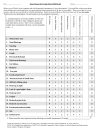Validation and Cross-cultural Adaptation of the Sinonasal Outcome Test (SNOT)-22 for the Arabian Patient Population
- PMID: 31245231
- PMCID: PMC6559682
- DOI: 10.7759/cureus.4447
Validation and Cross-cultural Adaptation of the Sinonasal Outcome Test (SNOT)-22 for the Arabian Patient Population
Abstract
Background and objective Quality of life measurement is an essential element of healthcare evaluation. The Sino-Nasal Outcome Test 22 (SNOT-22) has been validated in different languages, and in this study we validated the SNOT-22 in Arabic language. The objective of this study is to provide a validated, cross-culturally adapted version of the SNOT-22 for the Arabic speaking population. Materials, methods, and main outcome measures This was a prospective cohort study set in a tertiary hospital in Riyadh, Saudi Arabia. The SNOT-22 was translated into Arabic by two native Arabic speakers. A total of 30 patients with chronic rhinosinusitis (CRS) with/without nasal polyps were included in test-retest study. Following that, a prospective study was conducted where the translated SNOT-22 was distributed to a different set of 30 CRS patients before and three months after endoscopic sinus surgery. Another 50 healthy individuals were included as a control group. The main outcome measure was the translation and validation of the SNOT-22 in Arabic. Results Internal consistency was assessed by performing a test-retest study. Cronbach's alpha was 0.803 at both the initial examination and at the retest, showing good internal consistency. There was a statistically significant difference between the results of the control group and the preoperative results of the CRS group (p<.001). The preoperative mean (SD) SNOT-22 score for the CRS group was 64.8 (20.3) and it dropped to 29.2 (11.8) postoperatively showing statistically significant change (p<.001), indicating the responsiveness of the SNOT-22. Conclusion The Arabic version of the SNOT-22 has internal consistency, reliability, and reproducibility that is needed for it to be a valid instrument to be used in research and clinical practice.
Keywords: arabic; chronic rhinosinusitis; crs; quality of life; sinonasal outcome test; sinus surgery; sinusitis; snot; snot-22; validation.
Conflict of interest statement
The authors have declared that no competing interests exist.
Figures
Similar articles
-
Psychometric Validation of a Moroccan Version of the 22-Item Sino-Nasal Outcome Test.Otolaryngol Head Neck Surg. 2016 Oct;155(4):681-7. doi: 10.1177/0194599816650477. Epub 2016 May 17. Otolaryngol Head Neck Surg. 2016. PMID: 27188703
-
Psychometric Arabic Sino-Nasal Outcome Test-22: validation and translation in chronic rhinosinusitis patients.Ann Saudi Med. 2018 Jan-Feb;38(1):22-27. doi: 10.5144/0256-4947.2018.22. Ann Saudi Med. 2018. PMID: 29419525 Free PMC article.
-
The sino-nasal outcome test (SNOT)-22: validation for Greek patients.Eur Arch Otorhinolaryngol. 2014 Oct;271(10):2723-8. doi: 10.1007/s00405-014-2969-7. Epub 2014 Mar 5. Eur Arch Otorhinolaryngol. 2014. PMID: 24595707
-
Systematic Review and Meta-analysis of SNOT-22 Outcomes after Surgery for Chronic Rhinosinusitis with Nasal Polyposis.Otolaryngol Head Neck Surg. 2018 Sep;159(3):414-423. doi: 10.1177/0194599818773065. Epub 2018 May 1. Otolaryngol Head Neck Surg. 2018. PMID: 29712509
-
Sinonasal quality-of-life outcomes after endoscopic endonasal skull base surgery.Int Forum Allergy Rhinol. 2019 Oct;9(10):1105-1118. doi: 10.1002/alr.22398. Epub 2019 Jul 29. Int Forum Allergy Rhinol. 2019. PMID: 31356005 Review.
Cited by
-
Cross-cultural adaptation and validation of the 22-item sinonasal outcome test (SNOT-22) in German-speaking patients: a prospective, multicenter cohort study.Eur Arch Otorhinolaryngol. 2022 May;279(5):2433-2439. doi: 10.1007/s00405-021-07019-6. Epub 2021 Aug 5. Eur Arch Otorhinolaryngol. 2022. PMID: 34351466 Free PMC article.
-
Functional Outcomes of Endoscopic Sinus Surgery: A Prospective Cohort Study Using the Sino-Nasal Outcome Test-16 Questionnaire.Cureus. 2024 Sep 13;16(9):e69322. doi: 10.7759/cureus.69322. eCollection 2024 Sep. Cureus. 2024. PMID: 39398706 Free PMC article.
-
Sensibility, specificity, and accuracy of the Sinonasal Outcome Test 8 (SNOT-8) in patients with chronic rhinosinusitis (CRS): a cross-sectional cohort study.Eur Arch Otorhinolaryngol. 2023 Jul;280(7):3259-3264. doi: 10.1007/s00405-023-07855-8. Epub 2023 Jan 27. Eur Arch Otorhinolaryngol. 2023. PMID: 36705726
-
Does Managing Patients With Chronic Rhinosinusitis Improve Their Depression Score? Prospective Study.J Otolaryngol Head Neck Surg. 2024 Jan-Dec;53:19160216241248668. doi: 10.1177/19160216241248668. J Otolaryngol Head Neck Surg. 2024. PMID: 38888948 Free PMC article.
-
Sino-Nasal Outcome Test-22: translation, cross-cultural adaptation, and validation in Polish-speaking patients.Eur Arch Otorhinolaryngol. 2024 Dec;281(12):6431-6443. doi: 10.1007/s00405-024-08919-z. Epub 2024 Aug 28. Eur Arch Otorhinolaryngol. 2024. PMID: 39198305 Free PMC article.
References
-
- EPOS 2012: European position paper on rhinosinusitis and nasal polyps 2012. A summary for otorhinolaryngologists. Fokkens WJ, Lund VJ, Mullol J, et al. Rhinology. 2012;50:1–12. - PubMed
-
- Translation cross-cultural adaptation, and validation of the sino-nasal outcome test (SNOT)-22 for Lithuanian patients. Vaitkus S, Padervinskis E, Balsevicius T, et al. Eur Arch Otorhinolaryngol. 2013;270:1843–1848. - PubMed
-
- Quality of life in patients with chronic rhinosinusitis. Rudmik L, Smith TL. Curr Allergy Asthma Rep. 2011;11:247–252. - PubMed
-
- Psychometric and clinimetric validity of the 20-Item SinoNasal Outcome Test (SNOT-20) Piccirillo JF, Merritt MG, Jr Richards ML. Otolaryngol Head Neck Surg. 2002;126:41–47. - PubMed
-
- The Sino-Nasal Outcome Test (SNOT): can we make it more clinically meaningful? Browne JP, Hopkins C, Slack R, Cano SJ. Otolaryngol Head Neck Surg. 2007;136:736–741. - PubMed
LinkOut - more resources
Full Text Sources


